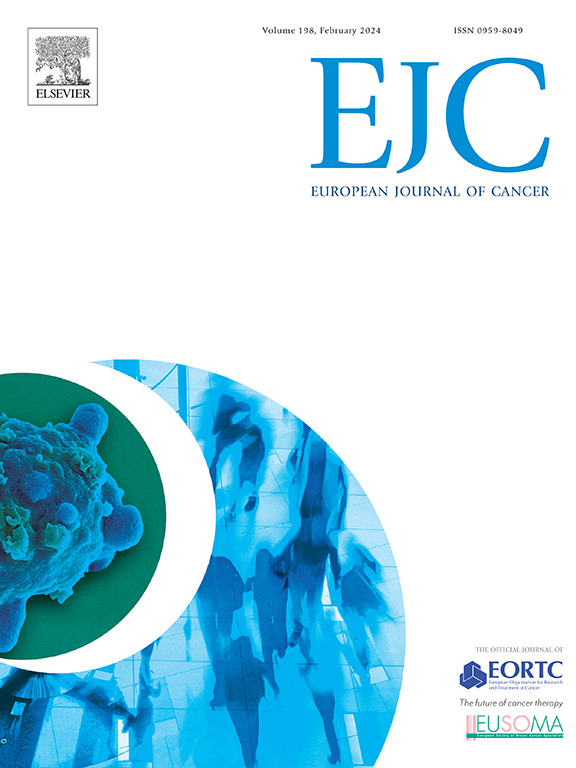胆道癌切除后的辅助化疗与观察化疗的比较:iii期随机对照试验的生存荟萃分析
IF 7.6
1区 医学
Q1 ONCOLOGY
引用次数: 0
摘要
有限数量的随机对照试验(RCTs)研究了胆道肿瘤(btc)的辅助化疗。复发和死亡在前2年很常见,尽管进行了辅助治疗,生存率仍然很低。方法采用iii期随机对照试验(rct),比较辅助化疗与切除btc的观察效果。主要终点为无复发(RFS)和总生存期(OS)。比例风险结果用于基于试验的分析。根据已发表的Kaplan-Meier曲线整理患者数据,分析短期(2年)风险。采用Parmar和通用逆方差法。结果4项试验(BILCAP、ASCOT、BCAT、PRODIGE-12)共纳入1308例患者。卡培他滨(BILCAP)和S-1 (ASCOT)分为5- fu为主,吉西他滨(BCAT)和吉西他滨-奥沙利铂(PRODIGE-12)分为吉西他滨为主。辅助5fu化疗可改善RFS [HR: 0.80(95 % CI: 0.68-0.95), p = 0.012]和OS [HR: 0.78(95 % CI: 0.65-0.94), p = 0.009]。然而,以吉西他滨为基础的化疗在RFS [HR: 0.90(95 % CI: 0.70-1.15), p = 0.428]和OS [HR: 1.03(95 % CI: 0.78-1.36), p = 0.794]中没有提供益处。以5- fu为基础的化疗的益处在短期(2年风险)中更为明显(RFS: [HR: 0.67(95 %CI: 57-0.79), p <; 0.001]和OS: [HR: 0.61(95 %CI: 59-0.64), p <; 0.001])。然而,吉西他滨为基础的化疗在短期内也没有提供RFS益处[HR: 0.80(95 % CI: 0.64-0.1.01), p = 0.067],甚至在前2年似乎对OS有害[HR: 1.22(95 % CI: 1.14-1.31), p <; 0.001]。结论本研究证实以5fu为基础的单药治疗可辅助治疗切除的btc。前2年更突出的获益强调了需要更有效的辅助治疗并持续长期获益。2年比例风险OS和RFS在这里被提议作为未来临床试验中考虑的额外次要终点。在这种情况下。注册ID (PROSPERO): CRD42024614444本文章由计算机程序翻译,如有差异,请以英文原文为准。
Adjuvant chemotherapy compared to observation in resected biliary tract cancers: Survival meta-analysis of phase-III randomized controlled trials
Background
A limited number of randomized controlled trials (RCTs) investigated adjuvant chemotherapy in biliary tract cancers (BTCs). Recurrences and deaths are common in the first 2 years and survival remains poor despite adjuvant treatment.
Methods
Phase-III RCTs were included comparing adjuvant chemotherapy and observation in resected BTCs. The primary endpoints were recurrence-free (RFS) and overall survival (OS). Proportional hazard results were used for trial-based analyses. Patient data was curated from published Kaplan-Meier curves to analyze short-term (2-year) hazards. The Parmar and generic inverse variance methods were used.
Results
1308 patients in 4 trials (BILCAP, ASCOT, BCAT, PRODIGE-12) were included. Capecitabine (BILCAP) and S-1 (ASCOT) were grouped as 5-FU-based, gemcitabine (BCAT) and gemcitabine-oxaliplatin (PRODIGE-12) were grouped as gemcitabine-based chemotherapy. Adjuvant 5FU-based chemotherapy improved RFS [HR: 0.80 (95 % CI:0.68–0.95), p = 0.012] and OS [HR: 0.78 (95 % CI:0.65–0.94), p = 0.009]. However, gemcitabine-based chemotherapy did not provide benefit in RFS [HR: 0.90 (95 % CI:0.70–1.15), p = 0.428] and OS [HR: 1.03 (95 % CI:0.78–1.36), p = 0.794]. The benefit of 5-FU-based chemotherapy was more apparent in the short-term (2-year hazards) (RFS: [HR: 0.67 (95 %CI:57–0.79), p < 0.001] and OS: [HR: 0.61 (95 % CI:59–0.64), p < 0.001]). However, gemcitabine-based chemotherapy did not provide RFS benefit in the short term either [HR: 0.80 (95 % CI:0.64–0.1.01), p = 0.067] and seemed to be even detrimental for OS [HR: 1.22 (95 % CI:1.14–1.31), p < 0.001] in the first 2 years.
Conclusion
This study confirms using 5FU-based monotherapy in the adjuvant treatment of resected BTCs. The more prominent benefit in the first 2 years emphasizes that more effective adjuvant treatments with sustained long-term benefits are needed. Two-year proportional hazards OS and RFS are proposed here as an additional secondary end-point to consider in future clinical trials. in this setting.
Registration ID (PROSPERO): CRD42024614444
求助全文
通过发布文献求助,成功后即可免费获取论文全文。
去求助
来源期刊

European Journal of Cancer
医学-肿瘤学
CiteScore
11.50
自引率
4.80%
发文量
953
审稿时长
23 days
期刊介绍:
The European Journal of Cancer (EJC) serves as a comprehensive platform integrating preclinical, digital, translational, and clinical research across the spectrum of cancer. From epidemiology, carcinogenesis, and biology to groundbreaking innovations in cancer treatment and patient care, the journal covers a wide array of topics. We publish original research, reviews, previews, editorial comments, and correspondence, fostering dialogue and advancement in the fight against cancer. Join us in our mission to drive progress and improve outcomes in cancer research and patient care.
 求助内容:
求助内容: 应助结果提醒方式:
应助结果提醒方式:


